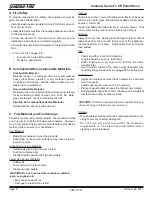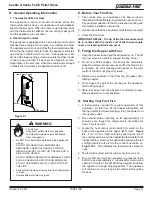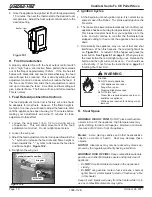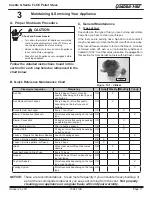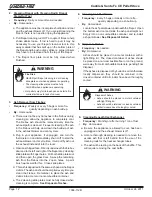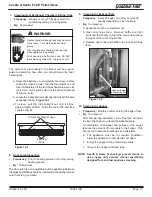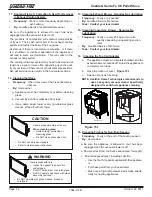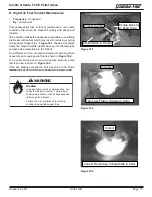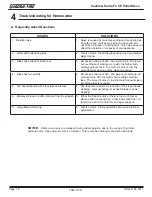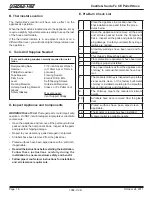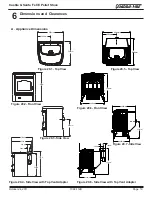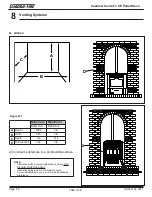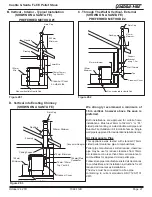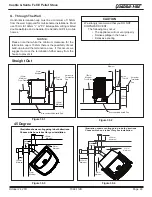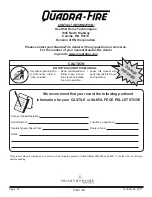
Page 22
October 24, 2011
Castile & Santa Fe CE Pellet Stove
R
7068-112B
Do not terminate vent
in any enclosed or semi-enclosed
area such as a carport, garage, attic, crawl space, under a
sun deck or porch, narrow walkway or closely fenced area,
or any location that can build up a concentration of fumes
such as a stairwell, covered breezeway, etc.
CAUTION
A. Venting Termination Requirements
1
.
Termination must exhaust above air inlet elevation.
It is
strongly recommended that at least 1.5m of vertical
pipe be installed when appliance is vented directly
through a wall.
This will create a natural draft, which
will help prevent the possibility of smoke or odor venting
into the home during a power outage. It will also keep
exhaust from causing a nuisance or hazard by exposing
people or shrubs to high temperatures. The safest and
preferred venting method is to extend the vent vertically
through the roof.
2
.
Distance from
doors and opening windows, or gravity or
ventilation air inlets into building:
a. Not less than 1.2m below;
b. Not less than 1.2m horizontally from;
c. Not less than 305mm above.
3
.
Distance from permanently closed windows;
a. Not less than 305mm below; horizontally from or
above.
4
.
Distance between
bottom of termination and grade should
be 305mm minimum. This is conditional upon plants in
the area, and nature of grade surface. The grade sur
-
face must be a non-combustible material (i.e., rock, dirt).
The grade surface must not be lawn. Distance between
bottom of termination and public walkway should be
2.13m minimum.
5
.
Distance to combustible
materials must be 610mm
minimum. This includes adjacent buildings, fences,
protruding parts of the structure, roof overhang, plants
and shrubs, etc.
6. Termination Cap Location (Home Electrical Service)
• Side-to-side clearance is to be the same as minimum
clearance to vinyl inside corners.
• Clearance of a termination cap below electrical service
shall be the same as minimum clearance to vinyl soffits.
• Clearance of a termination cap above electrical service
will be 305mm minimum.
• Location of the vent termination must not obstruct or
interfere with access to the electrical service.
7
Vent Information
B. Avoiding Smoke and Odors
Negative Pressure, Shut-Down and Electrical Power
Failure
To reduce the probability of back-drafting or burn-back in
the pellet appliance during power failure or shut down con
-
ditions, it must be able to draft naturally without exhaust
blower operation.
Negative pressure in the house will resist this natural draft if
not accounted for in the pellet appliance installation.
Heat rises in the house and leaks out at upper levels. This
air must be replaced with cold air from outdoors which flows
into lower levels of the house.
Vents and chimneys into basements and lower levels of the
house can become the conduit for air supply and reverse
under these conditions.
Outside Air
An outside air kit is recommended in all installations. The
Outside Air Kit must be ordered seperately.
Per your local building codes, consideration must be given
to combustion air supply to all combustion appliances.
Failure to supply adequate combustion air for all appliance
demands may lead to backdrafting of those and other appli
-
ances.
When the appliance is roof vented (strongly recommended):
The air intake is best located on the exterior wall ori
-
ented towards the prevailing wind direction during the
heating season.
When the appliance is side-wall vented:
The air intake is best located on the same exterior wall
as the exhaust vent outlet and located lower on the wall
than the exhaust vent outlet.
The outside air supply kit can supply most of the demands
of the pellet appliance, but consideration must be given to
the total house demand.
House demand may consume the air needed for the appli
-
ance. It may be necessary to add additional ventilation to
the space in which the pellet appliance is located.
Consult with your local heating professional to determine
the ventilation demands for your house.

